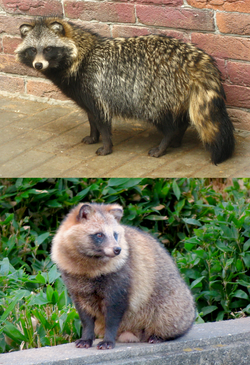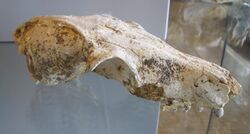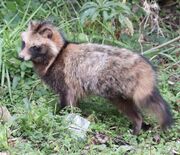Biology:Nyctereutes
| Nyctereutes[1] | |
|---|---|

| |
| Common and Japanese raccoon dog | |
| Scientific classification | |
| Domain: | Eukaryota |
| Kingdom: | Animalia |
| Phylum: | Chordata |
| Class: | Mammalia |
| Order: | Carnivora |
| Family: | Canidae |
| Subfamily: | Caninae |
| Genus: | Nyctereutes Temminck, 1838[2] |
| Type species | |
| Canis viverrinus Temminck, 1838[1]
| |
| Species | |
Nyctereutes (Greek: nyx, nykt- "night" + ereutēs "wanderer") is a genus of canid which includes only two extant species, both known as raccoon dogs: the common raccoon dog (Nyctereutes procyonoides) and the Japanese raccoon dog (Nyctereutes viverrinus).[1] Nyctereutes first entered the fossil record 5.5 million years ago (Mya) in northern China. It was one of the earliest canines to arrive in the Old World. All but two species became extinct before the end of the Pleistocene. A study suggests that the evolution of Nyctereutes was influenced by environmental and climatic changes, such as the expansion and contraction of forests and the fluctuations of temperature and precipitation.[3]
Characteristics
They are typically recognized by their short snouts, round crania and the shaping of their molars, specifically the ratio between M1 and M2. Nyctereutes is considered mainly an opportunistic carnivore, feeding on small mammals, fish, birds, and insects, alongside occasional plants, specifically roots. Their diet is mostly influenced by environmental factors.[3] Japanese raccoon dogs are considered distinct from the mainland species because of the larger skull size found in Russian and Hokkaido raccoon dogs.[4]
Species
Extant species
| Common name | Scientific name and subspecies | Range | Size and ecology | IUCN status and estimated population |
|---|---|---|---|---|
| Common raccoon dog | Nyctereutes procyonoides (Gray, 1834) Four subspecies
|
Mongolia, Russian Far East, China, Korea, Vietnam; introduced to Europe
|
Size: Habitat: Diet: |
LC
|
| Japanese raccoon dog | Nyctereutes viverrinus (Temminck, 1838) |
Japan | Size: Habitat: Diet: |
LC
|
Fossil species
- †Nyctereutes abdeslami 3.6—1.8 Mya (Morocco)[5]
- †Nyctereutes donnezani 9.0—3.4 Mya (Eastern Europe, Spain)
- †Nyctereutes lockwoodi 3.42—3.2 Mya (Ethiopia)[6]
- †Nyctereutes megamastoides (Europe)[3]
- †Nyctereutes sinensis 3.6 Mya—781,000 years ago (Eastern Asia)[7]
- †Nyctereutes tingi[3]
- †Nyctereutes vinetorum[citation needed]
References
- ↑ 1.0 1.1 1.2 Wozencraft, W.C. (2005). "Genus Nyctereutes". in Wilson, D.E.; Reeder, D.M. Mammal Species of the World: A Taxonomic and Geographic Reference (3rd ed.). Johns Hopkins University Press. pp. 532–628. ISBN 978-0-8018-8221-0. OCLC 62265494. http://www.departments.bucknell.edu/biology/resources/msw3/browse.asp?id=14000824.
- ↑ Temminck, C.J. (1838). "Over de Kennis en de Verbreiding der Zoogdieren van Japan" (in nl). Tijdschrift voor Natuurlijke Geschiedenis en Physiologie 5: 273–293. https://www.biodiversitylibrary.org/page/13475079.
- ↑ 3.0 3.1 3.2 3.3 Farjand, Arya; Zhang, Zhao-Qun; Liu, Wen-Hui; Jiao, Chen-Hui; Wang, Li-Hua (June 2021). "The evolution of Nyctereutes (Carnivora: Canidae) in the Nihewan Basin, Hebei, northern China". Palaeoworld 30 (2): 373–381. doi:10.1016/j.palwor.2020.07.002.
- ↑ Kim, Sang-In; Oshida, Tatsuo; Lee, Hang; Min, Mi-Sook; Kimura, Junpei (2015). "Evolutionary and Biogeographical implications of variation in skull morphology of raccoon dogs (Nyctereutes procyonoides, Mammalia: Carnivora)". Biological Journal of the Linnean Society 116 (1): 856–872. doi:10.1111/bij.12629.
- ↑ Paleobiology Database: ''Nyctereutes abdeslami basic info.
- ↑ Geraads, D. et al. (2010). "Nyctereutes lockwoodi, n. sp., a new canid (Carnivora: Mammalia) from the middle Pliocene of Dikika, Lower Awash, Ethiopia". Journal of Vertebrate Paleontology 30 (2): 981–987. doi:10.1080/02724631003758326.
- ↑ Paleobiology Database: ''Nyctereutes sinensis basic info.
Further reading
- Wayne, Robert K. (June 1993). "Molecular evolution of the dog family". Trends in Genetics 9 (6): 218–224. doi:10.1016/0168-9525(93)90122-x. PMID 8337763.
Wikidata ☰ Q2900104 entry
 |




